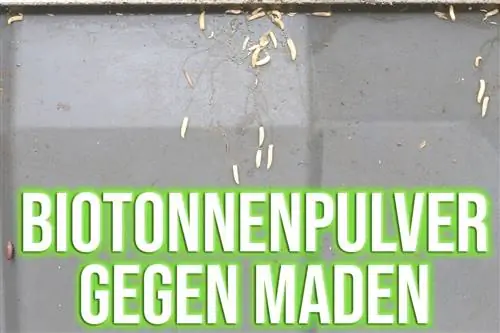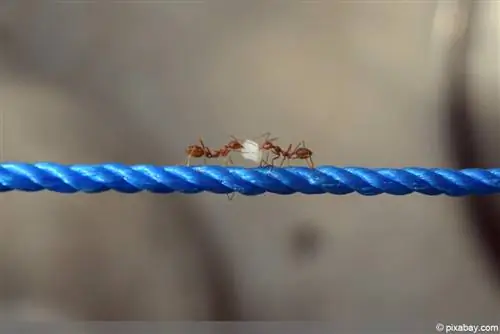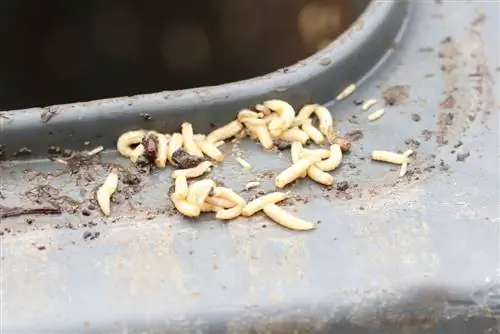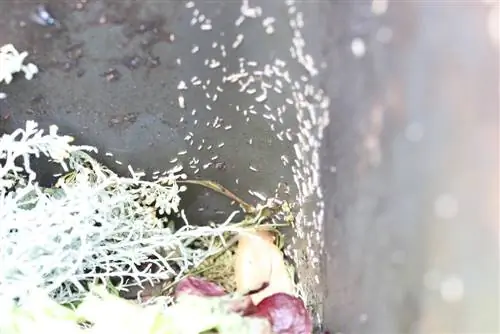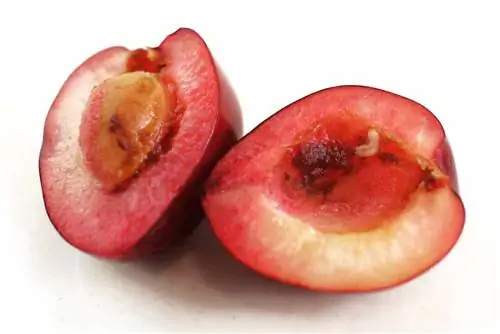- Author admin [email protected].
- Public 2023-12-17 03:39.
- Last modified 2025-06-01 06:48.
Nobody likes maggots in the organic waste bin. Nevertheless, they will almost certainly come to light again and again. However, you can effectively avoid visitors with organic bin powder.
Organic bin powder - what is it?
High-quality powders for the organic waste bin do not contain any chemicals, for example in the form of killing pesticides. Instead, the basis of all substrates is an individual mixture of the following components:
- Rock flour
- Diatomaceous earth
- Slaked lime
- Microorganisms
How does the powder work?
To understand the effect of organic bin powder, let's take a look at the function of the individual components:
Rock flour
Finely ground rock has an extremely high surface area to which it binds moisture. Its main task is therefore to absorb and bind moisture released from the organic waste.
Diatomaceous earth
This substance is made from the fossil remains of calcareous mussel shells, the “Gur”, using a burning process. In addition to the binding of moisture through an extremely high surface area of the microcrystalline substance, what is particularly valued in the organic waste bin is its biocidal effect. Due to its intensive drying effect, diatomaceous earth is used against bacteria and other germs. In addition, its sharp-edged particles are able to kill the larvae by causing intensive injuries to the digestive tract, even after the substance has been consumed.
Slaked lime
Calcium hydroxide is created by “slaking” quicklime with water. The resulting slaked lime is able to bind high amounts of moisture. In this reaction it develops a strongly corrosive effect due to its high alkalinity. Its task is to act as a disinfectant against putrefactive bacteria and other microorganisms in organic waste.
Microorganisms
On the one hand, the microorganisms in the organic waste are killed, and on the other hand, tiny creatures are added again.
How does this fit together?
The added microorganisms do not feed on the biomass of the kitchen waste, but rather they use its undesirable decomposition products, which attract flies. The task of the microorganisms is therefore primarily to reduce the pungent odor. This serves as the main attractant for all types of flies, which lead to undesirable maggot infestation by laying their eggs.
All of these functions are aimed at creating an environment that is as unattractive to flies as possible, so that other places for laying eggs are preferred.

Alternatives apart from deadly pesticides
In addition to ready-made organic bin powders, you also have the option of using some equally effective home remedies against maggots.
First and foremost are the individual components of the powder in their pure form. Rock powder, silica and slaked lime are freely available as pure substances and can of course also be distributed with organic waste.
ATTENTION:
Pure slaked lime can cause injuries to the skin and eyes due to its highly corrosive effect. Be sure to wear protective gloves and safety glasses when using it!
In addition, other substances available in every household can also be used wonderfully to keep the maggots away:
Vinegar water
Spray onto all internal surfaces of the organic waste bin and allow to dry - repels flies and caterpillars with a strong acidic smell
Essential oils (Lavender oil / Tea tree oil)
Place soaked rags around the edge of the barrel and clamp it with the lid - keeps flies away via scents
Pepper
Sprinkle organic waste over every layer - drives away maggots from the biomass
Tip:
Home remedies are usually less effective than real organic bin powder. Therefore, use home remedies especially for smaller bin sizes. The more organic waste you have, the more recommended it is to use professionally mixed powders right from the start.

